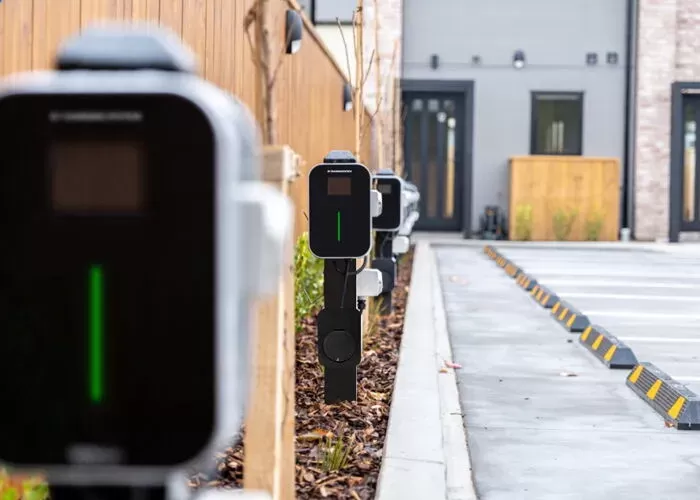Notifications

7 minutes, 47 seconds
-19 Views 0 Comments 0 Likes 0 Reviews

As electric vehicles (EVs) continue to gain popularity, the demand for efficient, reliable, and widely accessible charging infrastructure grows in parallel. Among the various options, AC (alternating current) EV charging remains the most common method used worldwide. Whether at home, work, or public locations, AC EV chargers are central to powering the transition toward electric mobility.
In this article, we’ll explore what AC charging is, how it functions, when it’s most effective, and why it is a smart choice for many EV owners. We’ll also highlight the pros and cons of AC charging and review key safety features built into modern systems.
AC charging refers to the delivery of electric power to an EV using alternating current—the standard electricity type powering homes and businesses. Unlike direct current (DC), which flows in a single direction, AC current periodically reverses direction.
AC charging is the most widely adopted EV charging method globally because it aligns with existing electrical infrastructure in residential and commercial buildings. It delivers power through standard or dedicated outlets and is best suited for locations where vehicles remain parked for extended periods, such as homes, apartments, offices, and shopping centers.
Voltage: 120 volts
Current: Up to 16 amps
Charging Speed: 2–5 miles of range per hour
Typical Use: Home charging via a standard wall outlet
Level 1 charging is the simplest and most accessible option. It involves plugging the EV into a regular 120V household outlet using the manufacturer-provided cable. Though slow, it suffices for drivers with short daily commutes and overnight charging.
Voltage: 240 volts
Current: Up to 80 amps
Charging Speed: 10–60 miles of range per hour
Typical Use: Homes, workplaces, public parking facilities
Level 2 charging requires a dedicated 240V outlet—similar to what large appliances use—and significantly reduces charging time. It is the preferred choice for most EV owners who want faster home or workplace charging.
Power Supply: Electricity is drawn from the grid as alternating current.
EV Supply Equipment (EVSE): The charger acts as the interface, managing communication, safety checks, and power delivery.
Onboard Charger: Located inside the EV, it converts AC to DC for battery storage.
Battery Storage: The EV’s lithium-ion battery stores the converted DC power.
This process leverages existing infrastructure without requiring specialized or high-voltage equipment, making AC charging versatile and cost-effective.
AC charging is ideal when vehicles can remain plugged in for extended periods, including:
Overnight Charging at Home: Plug in after work and wake up to a full battery.
Daytime Charging While Working from Home: Slow charging throughout the day maintains readiness without straining circuits.
Errand-Time Charging: Public Level 2 chargers at malls, grocery stores, or restaurants offer convenient range boosts during visits.
Workplace Charging: Employees can charge vehicles during office hours, utilizing otherwise idle time.
Modern AC chargers include multiple safety mechanisms to protect users and equipment:
Ground Fault Circuit Interrupter (GFCI): Detects current leaks to prevent shocks.
Overcurrent Protection: Stops excessive current flow to safeguard charger and battery.
Temperature Monitoring: Prevents overheating.
Automatic Shutoff: Stops charging once the battery is full.
Surge Protection: Shields against voltage spikes from lightning or grid instability.
Communication Protocols: Maintains real-time coordination between vehicle and charger.
These features make AC charging one of the safest methods for residential and workplace EV charging.
Cost-Effective Installation: Level 1 needs no upgrades; Level 2 installation is straightforward and affordable compared to DC fast chargers.
Low Operating Costs: AC chargers consume less power per hour and produce less heat, extending component life.
Battery Health: Slower charging is gentler on batteries, reducing thermal stress and extending battery longevity.
Broad Availability: Widely deployed in homes, apartments, workplaces, and public venues.
Compatibility: Most EVs support AC charging through universal ports like J1772 (North America), ensuring cross-brand interoperability.
Slower Charging Speeds: AC charging takes longer than DC fast charging—challenging for drivers needing rapid turnaround.
Lower Power Output: Even Level 2 chargers may require 8–12 hours to fully charge large battery EVs.
Potential Infrastructure Upgrades: Level 2 charging might require dedicated circuits or electrical panel upgrades in some buildings.
| Feature | AC Charging | DC Charging |
|---|---|---|
| Current Type | Alternating Current | Direct Current |
| Charging Speed | Slower (2–60 miles/hour) | Fast (80% in 20–60 minutes) |
| Charger Location | Residential, workplace, public | Highways, public hubs |
| Installation Cost | Lower | Higher |
| Battery Stress | Lower | Higher |
While DC fast chargers are critical for long-distance travel and public corridors, AC charging remains the backbone of daily EV use. It balances convenience, cost-efficiency, and battery health—making it ideal for most charging needs at home and work.
Governments and industry are expanding both AC and DC infrastructures, but the affordability and accessibility of AC charging make it the cornerstone of a sustainable charging network.
AC EV charging supports the everyday needs of EV drivers worldwide. Its cost-effectiveness, gentle battery handling, and broad availability make it the preferred choice for residential and workplace charging.
Whether you’re a homeowner installing a charger, a property manager accommodating tenants, or a city planner expanding public access, understanding AC charging’s role is key to building a sustainable, user-friendly EV ecosystem.
As EVs continue to replace gasoline cars, smart AC charging solutions will remain pivotal in driving a cleaner, more efficient transportation future.Know more about Google SEO Directory
China EV Chargers EV Charger Manufacturer EV Charging Solutions

